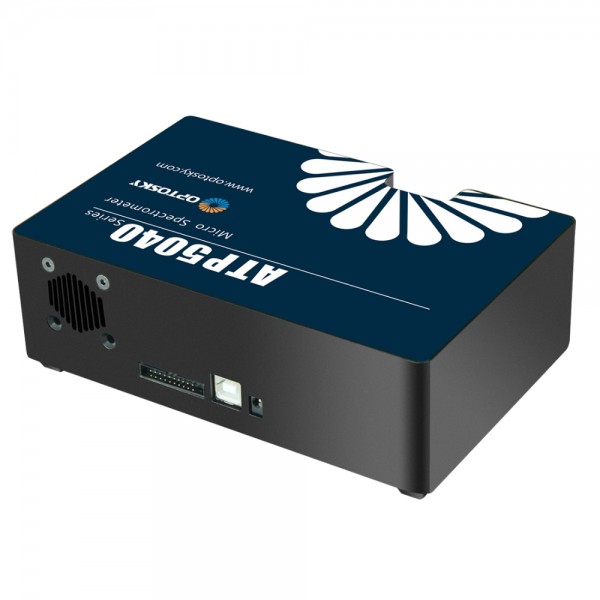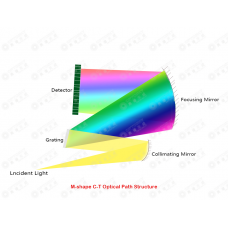Your shopping cart is empty!
ATP5040 High-resolution, UV-Vis Spectrometer
ATP5040 High-resolution, UV-Vis Spectrometer
5
5
Availability: In Stock
ATP5040 High-resolution, UV-Vis Spectrometer
Download Data Sheet
Product Code: ATP5040
application
- Optosky ATP5040 uses 4096pixels, other parameters almost the same as ATP5020, it employs the ultra-high performance, high-sensitivity, high-resolution, and cost-effective model. The award-winner spectrometer is called cooled Maya, it can even replace Maya and QE65 in SNR, sensitivity, and resolution. It's ideal for Raman system well. It uses, a back-thinned CCD array, TE-cooled down to -10 ℃. Sensor noise is further reduced, and SNR is almost 2 times higher than others. Increased reliability can remain measure result unchanged with temperature.
- Customized design of ultra-low noise CCD signal processing circuit built inside, Noise is lower can 3 counts is ahead of records in the industries.
- ATP5040 is designed with SMA905 optic fiber entrance connector or free space, and it outputs spectral data via USB2.0/UART
| Detector | |
| Detector type | Back-thinned Linear array detector, TE-cooled to -10℃ |
| Spectral range | 193-1008nm |
| Effective pixels | 4096pixels |
| Pixels dimension | 7x200 um |
| Full well capacity | NA |
| Detector model | hamamtsu s13496 +TEC |
| Sensitivity | 650 uV/e- |
| Dark noise | 0.4mVrms |
| Optical parameter | |
| Focal distance | 40/60mm |
| Optical resolution | 5 to 200 µm |
| Incident Interface | SMA905 connector,free space |
| Signal-to-noise | >600:1 |
| Dynamic range | 50000 |
| Working temperature | -10°c to + 50°c |
| Numberical aperture | 0.11 |
| Working humidity | < 90% NC |
| Trigger | YES(IN and OUT) |
| Cooling temperature | -5°c |
| Scanning rate | < 1 kfps |
| Wavelength range | 193-1008nm, 200-1000 nm, 200850nm, 600-1000nm, 800-1000nm |
| Slit Size | 50 μm (5, 10, 25, 50, 100, or 200 μm optional) |
| Optical Design | f/4 crossed asymmetrical Czerny-Turner |
| Physical parameters | |
| Dimensions | 170×110×52 mm^3 |
| Weight | 1.2kg |
| Sealing | Anit-sweat |
| Electrical parameter | |
| A/D conversion resolution | 18 bit |
| Integration time | 1 ms - 80 s |
| Interface | USB 2.0 (480MHz High speed) |
| Supply voltage | DC4.5 to 5.5 V (type @5V) |
| Operating current | <2.3A |
| Storage temperature | -30°c to + 70 °c |
- Detector:back-thinned CCD, TE-cooled down to -10 ℃
- CCD parameters:4096pixels, 14×14um
- Ultra-low noise CCD signal processing circuit
- Spectral range: 180-1180nm
- Spectral resolution: 0.01-1.3nm(depend on spectral range, slit width)
- Optical path:crossed Czerny-Turner (C-T)
- Integration time:1ms-130s
- power supply:DC 5V±10% @ <2.3A
- 18 bit, 570KHz A/D Converter
- Entrance connector:SMA905 connector or free space
- Output interface: high-speed USB2.0 or UART
- 20 pins, dual rows programmable extension connector
- Raman spectrometer
- Micro spectrophotometer,
- high-speed spectrophotometer
- Spectral analysis /radiation spectrophotometer/ spectrophotometric analysis
- Transmittance, absorbance, reflectance detection
- Wavelength detection
- LIBS
What are High Resolution & High Sensitivity & TE cooled Spectrometer from Optosky?
ATP5100 Ultra-miniature, Cooled BT CCD, sized up to a coin.
ATP5040 crossed C-T, TE-cooled 4096 pixels CMOS external cooling, high sensitivity
ATP5020P crossed C-T, Hamamatsu CCD cooled, higher sensitivity, SNR & dynamic range is higher than Maya.
ATP5030P M-shape C-T, higher resolution and low stray light, Hamamatsu CCD
ATP5030 (2048pixels) & ATP5034 (4096pixels) CMOS+TE-cooler, M-shape C-T, high resolution
ATP5330 (2048pixels) & ATP5334 (4096pixels) Thin, cooled CMOS+TE cooled, M-shape C-T, super high resolution
How many topology structure of optical path for a spectrometer?
There are commonly divided into 4 types of optical path, including crossed C-T, M-shape C-T, concave grating optical path, transmittance grating opitcal path.
Crossed C-T: ATP2000P,ATP2002, ATP2400, ATP1010, ATP5020P, ATP5040, ATP6500
M-shape C-T: ATP3030, ATP3034, ATP3330/4 ATP5030, ATP5034, ATP5330/4
Concave grating: ATP4230, ATP4020, ATP4050, ATP4070
let's see the M-shape optical path looks like a number "3", so our models uses the 3rd number "3" to indicate M-shape optical path models.
In generally, topology structure can decide resolution, sensitivity, stray light, and size of a spectrometer.
Crossed C-T topology structure employs better sensitivity and compact size.
M-shape C-T employs higher resolution and better stray light.
Concave grating optical path employs high stray light.









